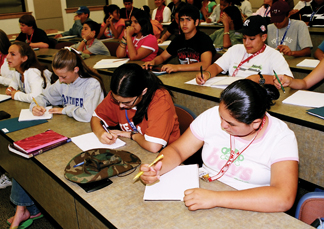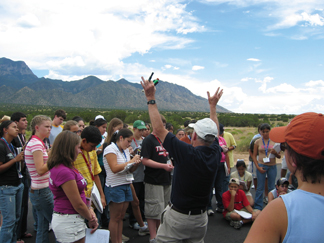Geotimes

Untitled Document

Education & Outreach
Geoscience Training in Full
Force
 Sabrina
Cervantez, a ninth grader at Del Rio Middle School in Texas, “loves learning
about Earth” and “how our planet actually is,” she says. “I
want to know how and why things work, how they function, how they do things
and why they do it.”
Sabrina
Cervantez, a ninth grader at Del Rio Middle School in Texas, “loves learning
about Earth” and “how our planet actually is,” she says. “I
want to know how and why things work, how they function, how they do things
and why they do it.”
Last year, as an eighth grader, Cervantez entered the school science fair with
a geology demonstration of plate tectonics, “but it didn’t really
get me that far,” Cervantez says, who at that point had never traveled
outside the state of Texas. That soon changed, however, after a teacher encouraged
her to apply for GeoFORCE Texas, a new summer program designed to shape the
next generation of earth scientists.
First-year GeoFORCE students take a look
at geology by learning about the rock cycle. Throughout the program, students
learn about geology in classrooms, at museums and in the outdoors. Photos are
courtesy of University of Texas at Austin, Jackson School of Geosciences.
In summer 2005, Doug Ratcliff, assistant dean of the Jackson School of Geociences
at the University of Texas in Austin, and colleagues launched GeoFORCE. Modeled
after the Mathematics, Science and Engineering Academy, created by Isaac Crumbly
at Fort Valley State University in Georgia, GeoFORCE selects 40 new students
per year who will spend about a week every summer from 9th through 12th grade
learning about careers in geology.
Ratcliff hopes that the intense program will address a key issue affecting
the geosciences: the declining number of students pursuing degrees in math and
science in “non-medicine-type” careers. Medicine is “pumped up
by TV and movies,” Ratcliff says. “We don’t have a show about
geologists driving Ferraris.” And among Cervantez’s classmates interested
in math and science careers outside of medicine, Cervantez says that most want
to pursue jobs in technology and engineering, not in the geosciences.
After reviewing statements from the students and recommendation letters, Ratcliff
and colleagues selected 40 students, including Cervantez, from a pool of top
math and science students from school districts across South Texas. “I
was screaming my head off, I was so happy,” Cervantes says, when she found
out she was chosen for the program. The students gathered in Uvalde, Texas,
before embarking on a 12-day cross-country trip to meet geoscientists, tour
national parks and learn about career opportunities in the geosciences.
Nestled within the busy 12 days was a stop at the U.S. Geological Survey (USGS)
in Reston, Va. There, GeoFORCE students explored career options through exhibits
presented by participants such as the National Oceanic and Atmospheric Administration,
the U.S. Environmental Protection Agency, and of course, USGS.
“The goal is to try to get more students into that math-science pipeline
that the nation is really thin on,” says Stephen Hammond, a USGS hydrologist
who worked to recruit exhibitors. A “huge bubble” of job vacancies
will affect almost all federal government jobs, from research to service, as
baby boomers prepare to retire, he says.
Cervantez says that prior to GeoFORCE, she was not aware of the “amazing”
variety of geoscience careers. She always knew she wanted to be a geologist,
but says she thought the field was limited to “certain categories.”
After visiting USGS, “I just got so excited,” she says, “there’s
hydrology, mineralogy — all these different fields.”
Also to help increase numbers of math and science students, Ratcliff and colleagues
targeted GeoFORCE toward the mostly Hispanic and underrepresented region of
South Texas, from which students have not tracked into the Jackson School in
high numbers. Hispanics make up about 87 percent of the population living in
the Lower Rio Grande Valley, one of the regions in southern Texas targeted by
GeoFORCE, according to Steve Murdock, a demographer for the Texas State Data
Center. And from the total population in that area, almost 80 of percent of
people over 25 years old had not pursued a post-high school degree. Part of
the reason, Ratcliff says, could be that the region is rural and not usually
on the trail of college or industry recruiters.
Ratcliff hopes that after four summers of GeoFORCE, the University of Texas,
and the Jackson School of Geosciences in particular, will be among the choices
of the college-bound students, but knows that there is no guarantee. “I
cannot tell you what a kid who is entering the ninth grade will do in four years,”
he says. “All we’re trying to do is make an impression on them and
show them what opportunities exist in the geosciences.”
Getting students into the field helps to make a lasting impression, says Leon
Long, a geologist at the Jackson School who led some of the GeoFORCE field trips.
A current college student recently told Long that after attending the introductory
geology class trip to study uplift, he decided to major in geological sciences.
Getting out into the field “has an enormous impact on these people,”
Long says.
 Last
year’s program included a trip to Carlsbad Caverns in New Mexico, the deepest
limestone cave and the fourth longest in the United States. A guide led a walk
through the cave, showing different types of limestone and where the area had
once been under the ocean. Cervantez admits she already knew some of the information
from reading about different types of geology, “but actually seeing it
and actually being able to go out there and get hands-on experience really made
it stick in my mind,” she says.
Last
year’s program included a trip to Carlsbad Caverns in New Mexico, the deepest
limestone cave and the fourth longest in the United States. A guide led a walk
through the cave, showing different types of limestone and where the area had
once been under the ocean. Cervantez admits she already knew some of the information
from reading about different types of geology, “but actually seeing it
and actually being able to go out there and get hands-on experience really made
it stick in my mind,” she says.
A geological field trip outside Taos,
N.M., allows students to apply classroom learning to the world around them.
GeoFORCE took students, some of whom had never traveled outside of Texas, to
get an up-close look at mountains, caves and other geologic features.
Funding for GeoFORCE comes from the program’s corporate sponsors, including
Shell, ConocoPhillips and BP, among others. The program is an all-expenses-paid
event for the students, and the sponsors hope that down the road, they will
see returns in that investment with more students deciding to enter geoscience
fields.
In addition to providing the funding, however, the sponsors also participate.
This summer, when the same group returns for year two of GeoFORCE, they will
go river rafting in Glen Canyon in Arizona and Utah, and geologists from the
sponsor companies will give presentations about the types of careers in geology.
At the same time, a new incoming class of 40 ninth graders will follow a similar
journey that students took the previous year, but pared back from 12 days to
one week. And those who do not make it into the GeoFORCE academy can apply to
Young Geoscientists, a two-day course that takes students hunting for fossils
and digging through quarries that are closer to their homestate, Texas.
After the first summer of GeoFORCE, Cervantez seems to have made up her mind
and says that she wants to become a planetary geologist. “It just blows
my mind to see that there is this whole other world out there outside our own
that we can explore.” Time will tell, however, if rafting in Glen Canyon
this summer will reveal to Cervantez another yet-undiscovered and equally captivating
geoscience career.
Kathryn Hansen
Back to top
Untitled Document

 Sabrina
Cervantez, a ninth grader at Del Rio Middle School in Texas, “loves learning
about Earth” and “how our planet actually is,” she says. “I
want to know how and why things work, how they function, how they do things
and why they do it.”
Sabrina
Cervantez, a ninth grader at Del Rio Middle School in Texas, “loves learning
about Earth” and “how our planet actually is,” she says. “I
want to know how and why things work, how they function, how they do things
and why they do it.”

 Last
year’s program included a trip to Carlsbad Caverns in New Mexico, the deepest
limestone cave and the fourth longest in the United States. A guide led a walk
through the cave, showing different types of limestone and where the area had
once been under the ocean. Cervantez admits she already knew some of the information
from reading about different types of geology, “but actually seeing it
and actually being able to go out there and get hands-on experience really made
it stick in my mind,” she says.
Last
year’s program included a trip to Carlsbad Caverns in New Mexico, the deepest
limestone cave and the fourth longest in the United States. A guide led a walk
through the cave, showing different types of limestone and where the area had
once been under the ocean. Cervantez admits she already knew some of the information
from reading about different types of geology, “but actually seeing it
and actually being able to go out there and get hands-on experience really made
it stick in my mind,” she says.
